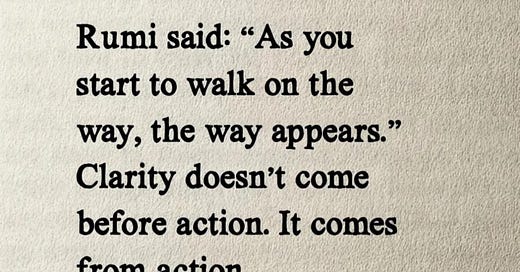Clarity: A Software Engineer's Journey
Clarity isn't just a state of understanding, it's a skill that must be harnessed
Recently, I found myself giving feedback to a team member that caught both of us by surprise: "Your need for clarity is blocking your productivity." This moment crystallized something I've observed throughout my career in software engineering—clarity isn't just a state of understanding, it's a skill that evolves, and sometimes our relationship with it needs to change for us to grow.
The Common Refrain: "Where Are the Requirements?"
It's a scene played out in development teams everywhere: A developer, faced with a new task, immediately asks, "Where are the requirements?" or states, "The requirements aren't clear enough to start." These are valid concerns, but they can also become crutches that hold us back from growth and learning.
The Junior Stage: Clarity as a Given
For junior developers, clarity often comes as a provided resource. They expect and need clarity to be delivered in a well-packaged form: detailed specifications, comprehensive documentation, and explicit instructions. This isn't a weakness—it's a natural starting point in their professional journey.
When faced with ambiguity, junior developers typically seek immediate clarification from more experienced team members. They rely on others to illuminate the path forward, much like students depending on teachers for guidance. This dependency serves an important purpose: it helps them build a foundation of understanding while contributing to projects under supervision.
The Mid-Level Transition: Actively Pursuing Clarity
As engineers gain experience, they begin to shift from passive recipients of clarity to active seekers. Mid-level developers learn that clarity isn't always readily available—it must be pursued. They develop the confidence to ask probing questions, challenge assumptions, and dig deeper into requirements.
This stage marks a crucial evolution in problem-solving abilities. Instead of waiting for clarity to be provided, these developers begin to:
Formulate targeted questions that cut to the heart of ambiguous issues
Identify potential gaps in specifications before they become problems
Seek out relevant documentation and resources independently
Engage in meaningful discussions with stakeholders to better understand requirements
The Senior Level: Embracing Ambiguity and Creating Clarity
The most significant transformation occurs when developers realize that perfect clarity is often an illusion. Sometimes you have to start without having the full knowledge. You prototype, you explore, you code something and eliminate wrong solutions until you get to the right one.
Senior developers understand that in complex systems and organizations, clarity often doesn't exist until someone creates it. They excel at:
Breaking down complex problems into manageable components
Starting with incomplete information and iterating
Using prototypes and proof-of-concepts as clarity-building tools
Creating documentation and architectural designs that provide clarity for others
Mentoring junior developers in the art of seeking and creating clarity
Breaking Through the Clarity Barrier
Often developers develop a habit of treating unclear requirements as a blocker. Ambiguous points became a reason to stop and wait for more information. While this cautious approach seems reasonable, it limits their growth and impact.
The breakthrough happens when seasoned developers don't just deal with ambiguity—they thrive in it. They understand that:
Perfect clarity is rare in real-world software development
Starting with incomplete information is often necessary
The process of building something can create clarity
Wrong turns and dead ends are valuable sources of learning
The ability to navigate ambiguity is what separates senior developers from junior ones
The need to scale or refactor an architecture is not a failure but often a sign of a successful and growing system
Changes to architecture or requirements are natural and should be embraced as part of the system's evolution, not as obstacles
Practical Approaches to Embracing Ambiguity
Instead of waiting for complete clarity, successful developers employ strategies like:
Breaking down large unknowns into smaller, testable hypotheses
Creating quick prototypes to test assumptions
Using iterative development to refine understanding
Maintaining open dialogue with stakeholders throughout the process
Documenting discoveries and decisions as they emerge
Incorporating A/B testing to validate ideas and measure their impact in real-world scenarios
Impact on Team Dynamics
This evolution in handling clarity has profound implications for team dynamics. Senior developers become multipliers of clarity, creating environments where:
Junior team members feel supported in their learning journey
Mid-level developers are encouraged to develop their clarity-seeking skills
The team as a whole becomes more effective at handling ambiguity
Knowledge sharing becomes more efficient and effective
Cultivating the Skill
Organizations can support this development by:
Creating safe spaces for junior developers to ask questions
Encouraging mid-level developers to lead discovery sessions
Encouraging senior developers to show vulnerability by asking questions in open forums
Recognizing and rewarding senior developers who excel at creating clarity
Establishing mentorship programs that focus on these skills
Promoting a bias for action to avoid unnecessary delays
Calling out analysis paralysis to keep teams moving forward
Documenting and sharing examples of effective clarity-seeking and creation
Conclusion
The progression from needing clarity to creating it is a fundamental aspect of engineering growth. Sometimes, as in the case of my team member, we need to recognize when our relationship with clarity needs to evolve. It's not just about technical expertise—it's about developing the confidence and skill to navigate the inherently ambiguous landscape of modern software development.
Understanding this progression helps both individual developers and organizations better support professional growth. It reminds us that clarity isn't just a prerequisite for good engineering—it's a skill that must be deliberately cultivated throughout one's career, and sometimes the best way to find clarity is to start building something before you have it all figured out.
Feel free to check out previously published articles-







